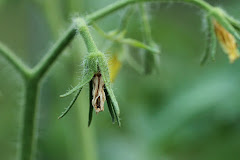 |
| Hardening off tomato transplants near house wall |
This week with temperatures in the eighties and nights in the fifties F has made it appear that summer has arrived and we're in the clear for transplanting. A closer look at next week's forecast reveals several days of night temperatures expected to be in the mid forties F. Such fluctuations are typical in high elevation, semiarid climates like ours.
Cool nights slow growth for warm weather plants and recovery takes days. This knocks time off your growing season and raises the question about waiting until night temperatures are consistently warm. I choose to keep plants actively growing by keeping plants indoors and plan to transplant later in the month. Of course if you transplant plants into water walls to raise night temperatures transplanting is a viable option.
Whenever you decide to transplant, do harden off plants by moving them outdoors on warm days and indoors at night. Place where protected and shaded to minimize winds and UV exposure until plants can toughen and develop self-protection against chlorophyll breakdown from UV rays. A location near a house wall under eaves or on a covered porch is fine. A week of hardening off to acclimate transplants to the outdoor environment is usually sufficient.
Photo credit: Hardening off tomato transplants - Carl Wilson






